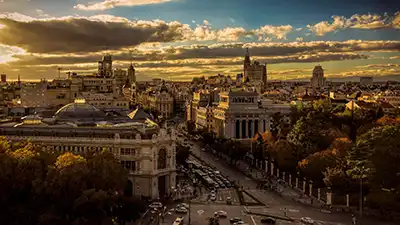Madrid: A Symphony of History, Art, and Passion
Madrid: A Symphony of History, Art, and Passion
Madrid, Spain’s sun-drenched capital, is a city where history hums through cobblestone streets, masterpieces whisper from grand museums, and the aroma of saffron-infused paella mingles with the clink of wine glasses. For travelers seeking a blend of grandeur and authenticity, Madrid offers an intoxicating journey through time, art, and the fiery soul of Spanish culture.
The Heartbeat of History
Madrid’s royal legacy unfolds at the Palacio Real (Royal Palace), a Baroque marvel with 3,418 rooms that stands as Europe’s largest functioning royal residence. Wander through its gilded halls, where frescoes by Tiepolo and Goya adorn ceilings, and the Royal Armory displays medieval armor fit for epic tales. Across the plaza, the Almudena Cathedral—a modernist contrast with its neo-Gothic spires—offers panoramic views of the city.
Nearby, the Plaza Mayor transports visitors to the 17th century. Once a stage for coronations and bullfights, this arcaded square now buzzes with street performers and café-goers sipping café con leche. For a taste of local life, head to Mercado de San Miguel, a wrought-iron market hall where Iberian ham, croquetas, and Galician oysters tempt every palate.
Art: The City’s Lifeline
Madrid’s “Golden Triangle of Art” is a pilgrimage for art lovers. The Prado Museum, home to Velázquez’s enigmatic Las Meninas and Goya’s haunting Black Paintings, spans eight centuries of European masterpieces. A short stroll away, the Reina Sofía jolts the senses with Picasso’s Guernica, a visceral anti-war mural that dominates its own gallery. Completing the trio, the Thyssen-Bornemisza bridges gaps between Renaissance portraits and Rothko’s abstract hues, offering a “greatest hits” of Western art.
Art here isn’t confined to museums. In Retiro Park, the Crystal Palace—a 19th-century glass pavilion—hosts avant-garde installations amid swan-dotted ponds. Locals flock here to row boats, picnic under, or catch impromptu flamenco performances—a reminder that Madrid’s creativity thrives outdoors.
Flamenco: Pulse of the Soul
To understand Madrid’s passion, one must experience flamenco. This art form, born in Andalusia, finds its fiercest interpreters in the capital’s tablaos. At Corral de la Morería, a dimly lit venue where Hemingway once clapped to the rhythm, dancers’ heels strike like thunder, guitars weep, and singers’ raw cante jondo (deep song) echoes centuries of joy and sorrow. Pair the performance with a glass of Rioja, and you’ll grasp why flamenco is UNESCO-listed—and utterly unforgettable.
Beyond the City: Day Trips into History
Madrid’s surroundings are dotted with treasures. Toledo, a UNESCO World Heritage site 40 minutes by train, is a medieval maze of synagogues, mosques, and Gothic cathedrals—a testament to Spain’s convivencia (coexistence) of faiths. Climb its stone alleys to El Greco’s former studio, then marvel at the Alcázar fortress towering above the Tagus River.
For royal escapades, the El Escorial Monastery—a colossal Renaissance complex—reveals Spain’s Habsburg glory. Built by Philip II, it houses a pantheon of kings and a library with illuminated manuscripts older than the New World. Alternatively, hop on the Strawberry Train to Aranjuez, where spring blooms in the Royal Palace gardens and terraced fountains evoke Versailles.

Tapas and Twilight
Madrid’s culinary scene is a jubilant chaos. Begin with churros con chocolate at Chocolatería San Ginés, a 24-hour institution since 1894. As dusk falls, join the tapeo (tapas crawl) in La Latina, where bars like Casa Lucas serve huevos rotos (broken eggs with Iberian ham) and patatas bravas doused in spicy alioli. For a splurge, Restaurante Botín—founded in 1725 and frequented by Hemingway—roasts suckling pig in oak-fired ovens, a recipe unchanged for three centuries.
End the night at Círculo de Bellas Artes’ rooftop, where gin-tonics accompany views of the Metropolis Building’s winged statue glowing against indigo skies.
Green Oases and Modern Pulse
Amid the urban bustle, Madrid’s parks offer respite. Retiro Park, once a royal retreat, invites leisurely strolls past rose gardens and the Alfonso XII Monument, a colonnade mirrored in a tranquil lake. For a wilder escape, Casa de Campo—a sprawling forest five times Central Park’s size—boasts hiking trails and a cable car soaring over the Manzanares River.
The city’s modern side shines in Chueca, Madrid’s LGBTQ+ hub, where boutiques and avant-garde galleries line rainbow-crosswalk streets. Nearby, Gran Vía—dubbed “Spain’s Broadway”—thrums with neon-lit theaters and flagship stores.
Practical Magic: Tips for Travelers
- Timing: Spring (April–June) and autumn (September–November) offer mild weather and fewer crowds.
- Transport: The metro is efficient, but walking unveils hidden plazas and street art. For day trips, high-speed trains link Toledo, Segovia, and Valencia in under two hours.
- Etiquette: Dinner starts late (9 PM onward). Greet shopkeepers with a “buenos días”—it’s the key to Madrileño warmth.
A City That Never Sleeps
Madrid is a city of contradictions: regal yet rebellious, timeless yet vibrantly alive. It’s in the laughter echoing from a vermuteria at midnight, the golden light bathing the Templo de Debod—an ancient Egyptian temple gifted to Spain—and the relentless energy of a fútbol match at Santiago Bernabéu Stadium. To visit Madrid is to surrender to its rhythm, where every corner promises a story, a flavor, or a flame that lingers long after departure.
As the Spanish say, “De Madrid al cielo”—from Madrid to heaven. And once you’ve wandered its streets, you’ll understand why.
¡Buen viaje!